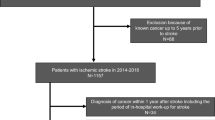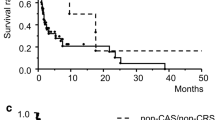Abstract
Cancer-associated ischemic stroke (CAS) refers to a hypercoagulation disorder related to malignant tumors, especially adenocarcinoma. Carbohydrate antigen (CA) 125 is a mucinous serum marker that might reflect hypercoagulation status, but the association between CA 125 and CAS is unclear across various types of cancer. The aim of this study was to investigate the associations among tumor markers, coagulation markers, and clinical factors in acute ischemic stroke (AIS) patients with active cancer. Consecutive AIS patients with active cancer (a diagnosis or ongoing active therapy for cancer within 6 months) were prospectively enrolled at four hospitals. D-dimer, C-reactive protein (CRP), carcinoembryonic antigen (CEA), CA19-9, and CA 125 levels were measured. Of 120 AIS patients with active cancer, 47 were diagnosed with CAS. CA 125 had the strongest correlations with D-dimer and CRP (ρ = 0.543, p < 0.001 and ρ = 0.452, p < 0.001, respectively). The areas under the receiver-operating characteristic curves for the diagnosis of CAS were 0.812 (95% CI 0.718–0.878) for CA 125, 0.714 (95% CI 0.602–0.801) for CEA, and 0.663 (95% CI 0.552–0.759) for CA 19-9. Multivariable analysis revealed that CA 125 levels in the highest quartile (OR 2.91, 95% CI 1.68–5.53), multiple lesions in multiple vascular territories observed on diffusion-weighted imaging, the absence of dyslipidemia, and the absence of atrial fibrillation were independently associated with CAS. Increased CA 125 levels, which indicate hypercoagulability, were useful for diagnosing CAS in AIS patients with active cancer.


Similar content being viewed by others
Availability of data and materials
The data that support the findings of this study are available from the corresponding author on reasonable request.
Code availability
Not applicable.
References
Bang OY, Chung JW, Lee MJ, Seo WK, Kim GM, Ahn MJ et al (2020) Cancer-related stroke: an emerging subtype of ischemic stroke with unique pathomechanisms. J Stroke 22:1–10
Dardiotis E, Aloizou AM, Markoula S, Siokas V, Tsarouhas K, Tzanakakis G et al (2019) Cancer-associated stroke: pathophysiology, detection and management (Review). Int J Oncol 54:779–796
Kim SG, Hong JM, Kim HY, Lee J, Chung PW, Park KY et al (2010) Ischemic stroke in cancer patients with and without conventional mechanisms: a multicenter study in Korea. Stroke 41:798–801
Schwarzbach CJ, Schaefer A, Ebert A, Held V, Bolognese M, Kablau M et al (2012) Stroke and cancer: the importance of cancer-associated hypercoagulation as a possible stroke etiology. Stroke 43:3029–3034
Finelli PF, Nouh A (2016) Three-territory DWI Acute infarcts: diagnostic value in cancer-associated hypercoagulation stroke (Trousseau Syndrome). AJNR Am J Neuroradiol 37:2033–2036
Shen Y, Li Y, Chen C, Wang W, Li T (2020) D-dimer and diffusion-weighted imaging pattern as two diagnostic indicators for cancer-related stroke: a case-control study based on the STROBE guidelines. Medicine (Baltimore) 99:e18779
Akaishi T, Kuroda H, Tateyama M, Yoshida Y, Otsuki T, Watanabe M et al (2015) Recurrent cerebral infarction synchronous with menorrhagia caused by endometrial stromal sarcoma. J Neurol Sci 358:509–511
Shao B, Wahrenbrock MG, Yao L, David T, Coughlin SR, Xia L et al (2011) Carcinoma mucins trigger reciprocal activation of platelets and neutrophils in a murine model of Trousseau syndrome. Blood 118:4015–4023
Long H, Qin K, Chen J, Chen Y, Chen L, Zeng J et al (2018) Biomarkers of gastric cancer-related ischemic stroke and its underlying pathogenesis. Medicine (Baltimore) 97:e0493
Xie X, Chen L, Zeng J, Qin C, Cheng D, Wei X et al (2016) Clinical features and biological markers of lung cancer-associated stroke. J Int Med Res 44:1483–1491
Lee AY, Levine MN, Baker RI, Bowden C, Kakkar AK, Prins M et al (2003) Low-molecular-weight heparin versus a coumarin for the prevention of recurrent venous thromboembolism in patients with cancer. N Engl J Med 349:146–153
Naito H, Nezu T, Hosomi N, Aoki S, Kinoshita N, Kuga J et al (2018) Controlling nutritional status score for predicting 3-mo functional outcome in acute ischemic stroke. Nutrition 55–56:1–6
Adams HP, Bendixen BH, Kappelle LJ, Biller J, Love BB, Gordon DL et al (1993) Classification of subtype of acute ischemic stroke. Definitions for use in a multicenter clinical trial. TOAST. Trial of Org 10172 in Acute Stroke Treatment. Stroke 24:35–41
Kang DW, Chalela JA, Ezzeddine MA, Warach S (2003) Association of ischemic lesion patterns on early diffusion-weighted imaging with TOAST stroke subtypes. Arch Neurol 60:1730–1734
DeLong ER, DeLong DM, Clarke-Pearson DL (1988) Comparing the areas under two or more correlated receiver operating characteristic curves: a nonparametric approach. Biometrics 44:837–845
Kim K, Lee JH (2014) Risk factors and biomarkers of ischemic stroke in cancer patients. J Stroke 16:91–96
Lee EJ, Nah HW, Kwon JY, Kang DW, Kwon SU, Kim JS (2014) Ischemic stroke in patients with cancer: is it different from usual strokes? Int J Stroke 9:406–412
Kneihsl M, Enzinger C, Wünsch G, Khalil M, Culea V, Urbanic-Purkart T et al (2016) Poor short-term outcome in patients with ischaemic stroke and active cancer. J Neurol 263:150–156
Gon Y, Sakaguchi M, Takasugi J, Kawano T, Kanki H, Watanabe A et al (2016) Plasma D-dimer levels and ischaemic lesions in multiple vascular regions can predict occult cancer in patients with cryptogenic stroke. Eur J Neurol 24(3):503–508
Das S, Batra SK (2015) Understanding the unique attributes of MUC16 (CA125): potential implications in targeted therapy. Cancer Res 75:4669–4674
Aiura R, Nakayama S, Yamaga H, Kato Y, Fujishima H (2021) Systemic thromboembolism including multiple cerebral infarctions with middle cerebral artery occlusion caused by the progression of adenomyosis with benign gynecological tumor: a case report. BMC Neurol 21:14
Jovin TG, Boosupalli V, Zivkovic SA, Wechsler LR, Gebel JM (2005) High titers of CA-125 may be associated with recurrent ischemic strokes in patients with cancer. Neurology 64:1944–1945
Miñana G, Núñez J, Sanchis J, Bodí V, Núñez E, Llàcer A (2010) CA125 and immunoinflammatory activity in acute heart failure. Int J Cardiol 145:547–548
Acknowledgements
We express our gratitude to Mayumi Oda at Chikamori Hospital, Mari Okamoto at Kawasaki Medical School, and Makiko Miyamoto at National Hospital Organization Kure Medical Center and Chugoku Cancer Center for their secretarial assistance. This study was supported by a research grant from the Japan Society for the Promotion of Science KAKENHI (grant numbers 17K17907 and 20K16579).
Funding
This study was supported by a research grant from the Japan Society for the Promotion of Science KAKENHI (grant numbers 17K17907 and 20K16579).
Author information
Authors and Affiliations
Contributions
TN: drafted and revised the manuscript for intellectual content, and collected data. NH, HN, SA, TT, TK, TS, DK, YM, TY, YY, NO, YS, NK, TK, HU, TO, and HM: revised the manuscript for intellectual content, and collected data.
Corresponding author
Ethics declarations
Conflict of interest
Hirofumi Maruyama received grants from Daiichi Sankyo Co., Ltd.; these grants are unrelated to the submitted work. All other authors declare that they have no conflicts of interest.
Ethical approval
This study complies with the Declaration of Helsinki guidelines for investigations involving humans, and the study protocol was approved by the Ethics Committees of each hospital (Hiroshima University Hospital; E-608, National Hospital Organization Kure Medical Center; 29–01, Kawasaki Medical School Hospital; 2621, and Chikamori Hospital; 223). As this study used clinical records, it was performed under the opt-out method.
Informed consent
Informed consent for participation was not obtained from the participants.
Additional information
Publisher's Note
Springer Nature remains neutral with regard to jurisdictional claims in published maps and institutional affiliations.
Supplementary Information
Below is the link to the electronic supplementary material.
Rights and permissions
About this article
Cite this article
Nezu, T., Hosomi, N., Naito, H. et al. Clinical characteristics and tumor markers in ischemic stroke patients with active cancer. Intern Emerg Med 17, 735–741 (2022). https://doi.org/10.1007/s11739-021-02862-1
Received:
Accepted:
Published:
Issue Date:
DOI: https://doi.org/10.1007/s11739-021-02862-1




